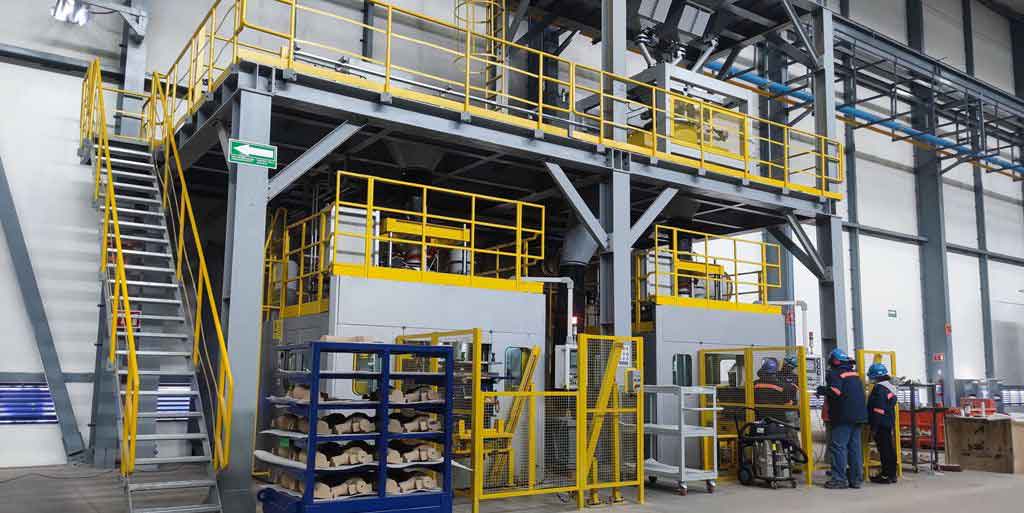This study investigates the mechanical properties and heat treatment optimization of copper-containing steel castings with varying wall thicknesses (300 mm, 400 mm, and 450 mm). The relationship between cooling rates, grain refinement, and precipitation strengthening mechanisms is analyzed through systematic experimentation and microstructural characterization.
1. Composition Design and Alloying Effects
The chemical composition of the copper-containing steel casting is designed to achieve a yield strength ≥370 MPa while maintaining excellent weldability and low-temperature toughness. Critical alloying elements and their functions are quantified as follows:
| Element | Content (wt.%) | Strengthening Mechanism |
|---|---|---|
| C | 0.10–0.13 | Interstitial solid solution strengthening: $\Delta \sigma_{ss} = 5,000 \cdot [C]$ |
| Cu | 0.50–0.80 | Precipitation strengthening: $\Delta \sigma_{ppt} = \frac{k f^{1/2}}{d}$ |
| Ni | 1.30–1.60 | Grain boundary strengthening: $\Delta \sigma_{gb} = k_y \cdot d^{-1/2}$ |
Where $f$ represents precipitate volume fraction, $d$ denotes grain size, and $k$ is a material constant. The nickel-to-copper ratio ($Ni/Cu > 1$) prevents hot cracking during solidification.

2. Heat Treatment Optimization
Three-stage heat treatment processes were applied to steel castings of different dimensions:
| Wall Thickness | Process Parameters | Cooling Method |
|---|---|---|
| 300 mm | 920°C × 7h + 620°C × 10h | Air/Forced air |
| 400 mm | 920°C × 9h + 620°C × 13h | Forced air |
| 450 mm | 920°C × 10h + 620°C × 15h | Air/Forced air |
The cooling rate ($\dot{T}$) significantly influences phase transformation kinetics:
$$ \dot{T} = \frac{T_{\text{start}} – T_{\text{end}}}{t_{\text{cool}}} $$
where $T_{\text{start}}$ and $T_{\text{end}}$ represent the initial and final temperatures of phase transformation, respectively.
3. Mechanical Performance Analysis
Mechanical properties were evaluated at surface, T/4, and core positions:
| Position | Yield (MPa) | Tensile (MPa) | Impact (-40°C) |
|---|---|---|---|
| 300 mm Surface | 392–398 | 509–521 | 63–73 J |
| 400 mm T/4 | 376–384 | 495–501 | 78–86 J |
| 450 mm Core | 358–367 | 480–487 | 79–86 J |
The strength gradient follows a parabolic relationship with wall thickness ($w$):
$$ \sigma_y(w) = \sigma_0 – k \cdot w^{1/2} $$
where $\sigma_0$ = 415 MPa and $k$ = 8.2 MPa/mm1/2 for this steel casting.
4. Microstructural Evolution
Dual-phase microstructure analysis revealed:
| Treatment | Grain Size (ASTM) | Phase Fraction |
|---|---|---|
| Single Normalizing | 6.5–7.0 | F:58%–P:42% |
| Double Normalizing | 7.5 | F:52%–P:48% |
Double normalizing enhances grain refinement through repeated γ→α phase transformations, increasing Hall-Petch strengthening:
$$ \sigma_{HP} = \sigma_0 + \frac{k}{\sqrt{d}} $$
where $k$ = 450 MPa·μm1/2 and $d$ = grain diameter.
5. Industrial Implementation
For steel castings exceeding 400 mm wall thickness, modified heat treatment parameters are proposed:
$$ t_{\text{hold}} = 0.5 \cdot w + 50 \quad (\text{min}) $$
where $w$ = wall thickness in mm. This ensures complete austenitization while minimizing energy consumption in large steel castings production.
The study demonstrates that copper-containing steel castings achieve optimal performance through controlled cooling strategies and microalloy design. The results provide critical guidelines for manufacturing heavy-section components in marine engineering applications.
